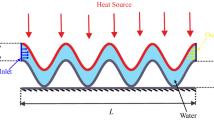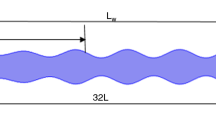Abstract
The convective heat transfer characteristics for a periodic wavy channel have been investigated experimentally and numerically. Finite volume method was used in numerical study. Experiment results are used for validation the numerical results. Studies were conducted for air flow conditions where contact angle is 30°, and uniform heat flux 616 W/m2 is applied as the thermal boundary conditions. Reynolds number (Re) is varied from 2000 to 11,000 and Prandtl number (Pr) is taken 0.7. Nusselt number (Nu), Colburn factor (j), friction factor (f) and goodness factor (j/f) against Reynolds number have been studied. The effects of the wave geometry and minimum channel height have been discussed. Thus, the best performance of flow and heat transfer characterization was determined through wavy channels. Additionally, it was determined that the computed values of convective heat transfer coefficients are in good correlation with experimental results for the converging diverging channel. Therefore, numerical results can be used for these channel geometries instead of experimental results.
















Similar content being viewed by others
Abbreviations
- C μ :
-
Turbulence model constant
- C 1ɛ :
-
Turbulence model constant
- C 2ɛ :
-
Turbulence model constant
- D h :
-
Hydraulic diameter (m)
- f :
-
Friction factor
- H :
-
Channel height (m)
- h :
-
Cycle average heat transfer coefficient (W/m2 K)
- h x :
-
Axially local heat transfer coefficient (W/m2 K)
- k :
-
Thermal conductivity (W/m K); turbulent kinetic energy (m2/s2)
- L :
-
Length (m)
- Nu :
-
Nusselt number
- P :
-
Pressure (Pa)
- Pr :
-
Prandtl number
- Pr t :
-
Turbulent Prandtl number
- Re :
-
Reynolds number
- S :
-
Pitch (axial length of cycle) (m)
- T :
-
Temperature (K)
- u i :
-
Velocity components (m/s)
- \( u_{i}^{{\prime }} \) :
-
Fluctuation velocity components (m/s)
- V :
-
Mean velocity (m/s)
- X :
-
Axial coordinate (m)
- x i :
-
Global coordinates
- ɛ :
-
Turbulent dissipation rate (m2/s3)
- θ :
-
Contact angle (°)
- λ :
-
Phase shift between side walls (°)
- μ :
-
Dynamic viscosity (kg/m s)
- μ t :
-
Turbulent viscosity (kg/m s)
- ρ :
-
Density (kg/m3)
- σ ɛ :
-
Diffusion Prandtl number for ɛ
- σ k :
-
Diffusion Prandtl number for k
- b:
-
Fluid bulk
- min:
-
Minimum
- max:
-
Maximum
- w:
-
Wall
References
Webb RL (1994) Principles of enhanced heat transfer. Wiley, New York
Kuppan T (2000) Heat exchanger design handbook. Marcel Dekker Inc., New York
Sparrow EM, Hossfeld LM (1984) Effect of rounding of protruding edges on heat transfer and pressure drop in a duct. Int J Heat Mass Transf 27:1715–1723
Gradeck M, Hoareau B, Lebouché M (2005) Local analysis of heat transfer inside corrugated channel. Int J Heat Mass Transf 48:1909–1915
Bilen K, Cetin M, Gul H, Balta T (2009) The investigation of groove geometry effect on heat transfer for internally grooved tubes. Appl Therm Eng 29:753–761
Elshafei EAM, Awad E, El-Negiry E, Ali AG (2010) Heat transfer and pressure drop in corrugated channels. Energy 35:101–110
Nilpueng K, Wongwises S (2006) Flow pattern and pressure drop of vertical upward gas liquid flow in sinusoidal wavy channels. Exp Therm Fluid Sci 30:523–534
Pehlivan H, Taymaz I, Islamoğlu Y (2013) Experimental study of forced convective heat transfer in a different arranged corrugated channel. Int Commun Heat Mass Transf. 46:106–111
Faghri M, Asako Y (1987) Numerical determination of heat transfer and pressure drop characteristics for a converging–diverging flow channels. Trans ASME 109:606–612
Wang G, Vanka SP (1995) Convective heat transfer in periodic wayv passages. Int J Heat Mass Transf 48(17):3219–3230
Nonino C, Comini G (1998) Finite-element analysis of convection problems in spatially periodic domains. Numer Heat Transf B 34:361–378
Natarjan S, Mokharzadeh-Denghan MR (2000) A numerical and experimental study of periodic flow in a model of a corrugated vessel with application to stented arteries. Med Eng Phys 22:555–556
Fabbri G (2000) Heat transfer optimization in corrugated wall channels. Int J Heat Mass Transf 43:4299–4310
Sawyers DR, Sen M, Chang HC (1998) Heat transfer enhancement in three-dimensional corrugated channel flow. Int J Heat Mass Transf 41:3559–3573
Islamoglu Y, Parmaksizoglu C (2004) Numerical investigation of convective heat transfer and pressure drop in a corrugated heat exchanger channel. Appl Therm Eng 24:141–147
Ničeno B, Nobile E (2001) Numerical analysis of fluid flow and heat transfer in periodic wavy channels. Int J Heat Fluid Flow 22:156–167
Grijspeerdt K, Hazarika B, Vucinic D (2003) Application of computational fluid dynamics to model the hydrodynamics of plate heat exchangers for milk processing. J Food Eng 57:237–242
Rosaguti NR, Fletcher DF, Haynes BS (2007) Low-Reynolds number heat transfer enhancement in sinusoidal channels. Chem Eng Sci 62:694–702
Naphon P (2008) Effect of corrugated plated in an in-phase arrangement of heat transfer and flow developments. Int J Heat Mass Transf 51:3963–3971
Eimsa-ard S, Promvonge P (2008) Numerical study on heat transfer of turbulent channel flow over periodic grooves. Int Commun Heat Mass Transf 35:844–852
Desrues T, Marty P, Fourmigue JF (2012) Numerical prediction of heat transfer and pressure drop in three-dimensional channels with alternated opposed ribs. Appl Therm Eng 45–46:52–63
Islamoglu Y (2008) Effect of rounding of protruding edge on convection heat transfer in a converging–diverging channel. Int Commun Heat Mass Transf 35:643–647
Sparrow EM, Comb JW (1983) Effect of inter-wall spacing and fluid flow inlet conditions on a corrugated-wall heat exchanger. Int J Heat Mass Transf 26:993–1005
Kline SJ, McClintock FA (1953) Describing uncertainties in single-sample experiments. Mech Eng 75:3–8
Launder BE, Spalding DB (1972) Lectures in mathematical model of turbulence. Academic Press, London
Ansys-Fluent User’s Guide, version 12.1, Ansys Inc. 2009
Patankar SV (1980) Numerical heat transfer and fluid flow, Hemisphere, Washington, DC
Author information
Authors and Affiliations
Corresponding author
Rights and permissions
About this article
Cite this article
Aslan, E., Taymaz, I. & Islamoglu, Y. Finite volume simulation for convective heat transfer in wavy channels. Heat Mass Transfer 52, 483–497 (2016). https://doi.org/10.1007/s00231-015-1571-x
Received:
Accepted:
Published:
Issue Date:
DOI: https://doi.org/10.1007/s00231-015-1571-x




